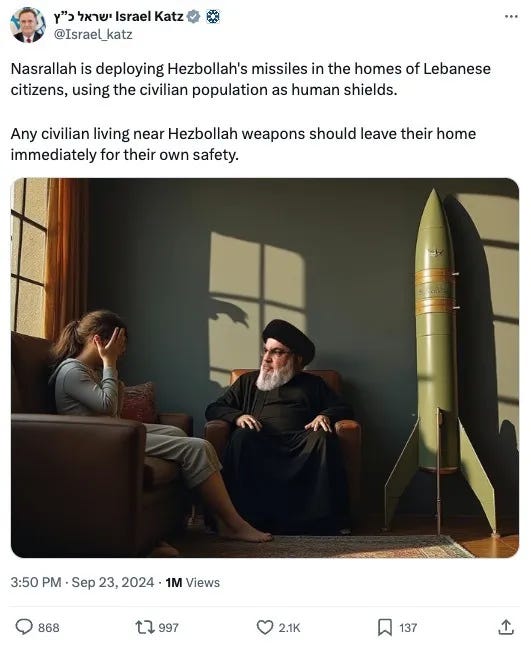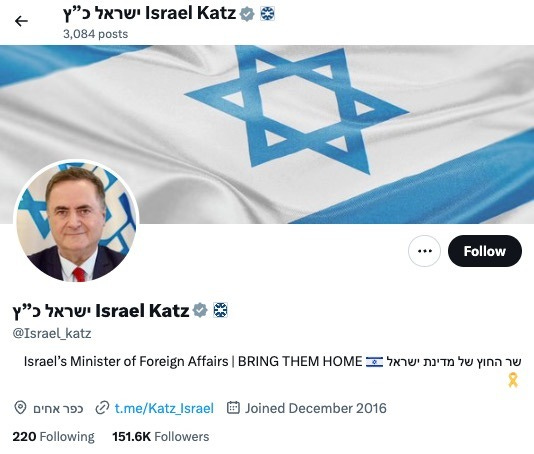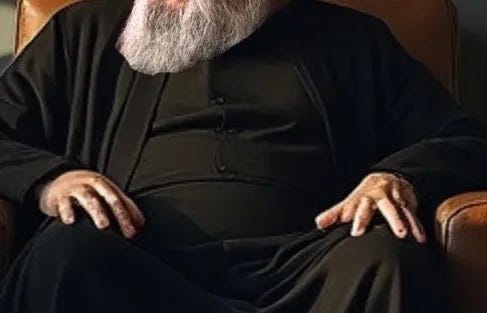Israeli Foreign Minister posted doctored image of Hezbollah chief featuring AI-generated material
The image is altered and includes a photograph of Hassan Nasrallah’s head that has been placed on an AI-generated scene.
CLAIM
An image posted to social media by Israeli Minister of Foreign Affairs, Israel Katz, depicted Hezbollah chief, Hassan Nasrallah, in a living room sitting beside a woman with her face in her hands, and flanked by a missile. In the caption, Katz claimed Nasrallah is “deploying Hezbollah’s missiles in the homes of Lebanese citizens”.
BACKGROUND
Israel Katz’s post on September 23 included an image of Nasrallah, apparently in the home of a woman who is crying into her hands. The pair can be seen sitting in armchairs, while a large missile stands on the floor beside the Hezbollah secretary-general.
In the caption on the post on X, Katz wrote from his official ministerial account: “Nasrallah is deploying Hezbollah’s missiles in the homes of Lebanese citizens, using the civilian population as human shields.
“Any civilian living near Hezbollah weapons should leave their home immediately for their own safety.”
The post was viewed a million times at the time of writing. The official account for Israel Katz, which bears the grey tick marking its affiliation with the state’s Ministry of Foreign Affairs, has more than 150,000 followers.
The post on X came the same day as a barrage of Israeli airstrikes across Lebanon, which killed at least 500 people, including at least 35 children, according to the Lebanese health ministry. Some 1,645 people were injured, according to the initial figures.
It was the deadliest day of conflict in Lebanon since 2006. Israel said it was targeting Hezbollah infrastructure and facilities in various locations across Lebanon in a new round of “extensive strikes”. It warned residents to stay away from so-called ‘Hezbollah sites’ in several areas of south Lebanon, and added that these sites include residential houses.
IDF spokesperson Rear Admiral Daniel Hagari said in a statement on Monday, September 23, that the Israeli military was striking homes because they contained Hezbollah weaponry. He said: “The scenes that can be seen now in southern Lebanon show Hezbollah’s weapons exploding inside homes. Every house that we strike contains weapons—rockets, missiles, UAVs that are intended to kill Israeli civilians.”
The September 23 airstrikes came as Lebanon was still reeling from a series of attacks last week involving pagers and walkie-talkies, some in use by Hezbollah members. Israel did not take responsibility for the incidents in clear terms, but Israeli Defence Minister Yoav Gallant announced a “new phase in the war” with military focus shifting north towards Lebanon.
Much of the international community has attributed the pager and walkie-talkie attacks to Israel, with briefings by security sources and analysis by military experts being cited by news media.
METHOD
The image posted by Israel Katz along with a statement about the Israeli government’s view of Hezbollah activity was unusual and bore several hallmarks of being AI-generated.
The image had a well-lit, airbrushed quality that is often seen in pictures created by generative AI programmes.
Taking a closer look at the image, our attention was drawn to the anatomy of the characters. Nasrallah’s face and beard appears in high-definition, but there is a sharp border where his beard ends and his clothing begins, suggesting the headshot was trimmed from another image and placed onto this one.
There are also issues with his hands: his fingers are poorly defined compared to the rest of his body, and do not sit naturally as they would in a true photograph of a person. The hands appear contorted and the length of some of the fingers are not in keeping with the rest of the hand.
The woman’s hands and legs are also worth a closer inspection. She appears to be missing a finger on the hand most visible, while behind that, there are inconsistencies with the area where her other hand should be.
Returning to the image of Nasrallah’s face, which appears to be taken from a real photograph and placed onto a body in an AI-generated image. We looked through a Google Image search for Hassan Nasrallah, and found the same image of the Hezbollah leader in use in news articles.
It is also the first available image result on Shutterstock upon searching his name, and was added to Shutterstock in 2023 by photographer Mohammad Kassir.
From this analysis, we can conclude that the Israeli Minister for Foreign Affairs used an altered image including an AI-generated scene in his post accusing Hezbollah of using Lebanese civilians as human shields.
RATING
The image is altered and includes a photograph of Hassan Nasrallah’s head that has been placed on an AI-generated scene.
SOURCES
X (formerly Twitter), @Israel_katz (2024). Nasrallah is deploying Hezbollah’s missiles in the homes of Lebanese citizens… [Accessed 24 Sep. 2024].
LIDMAN, M., BASSEM MROUE and HATOUM, B. (2024). Lebanon: Death toll from Israeli strikes rises to 492. [online] AP News. [Accessed 24 Sep. 2024].
Adams, P. (2024). Hezbollah pager explosions highlight shadow war. [online] BBC.com. [Accessed 24 Sep. 2024].
IDF press briefing (2024). Available at: Press Briefing by IDF Spokesperson RAdm. Daniel Hagari- September 23, 2024 [Accessed 24 Sep. 2024].
MERLIN, O. (2024). Nasrallah faces setbacks as Hezbollah weakens, prompting Israeli options. [online] The Jerusalem Post | JPost.com [Accessed 24 Sep. 2024].
Shutterstock. (2023). Beirut City-lebanon 29-7-2023 hezbollah Leader Hassan Nasrallah Stock Photo 2339562399 | Shutterstock. [online] [Accessed 24 Sep. 2024].








